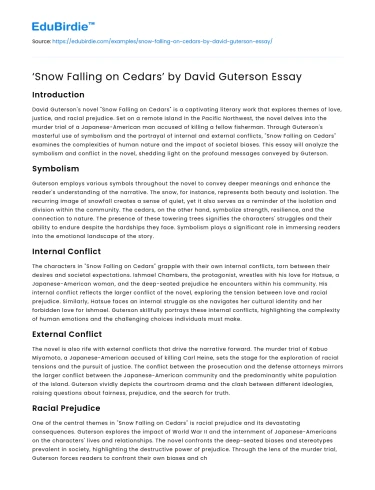Introduction
David Guterson's novel "Snow Falling on Cedars" is a captivating literary work that explores themes of love, justice, and racial prejudice. Set on a remote island in the Pacific Northwest, the novel delves into the murder trial of a Japanese-American man accused of killing a fellow fisherman. Through Guterson's masterful use of symbolism and the portrayal of internal and external conflicts, "Snow Falling on Cedars" examines the complexities of human nature and the impact of societal biases. This essay will analyze the symbolism and conflict in the novel, shedding light on the profound messages conveyed by Guterson.
Symbolism
Guterson employs various symbols throughout the novel to convey deeper meanings and enhance the reader's understanding of the narrative. The snow, for instance, represents both beauty and isolation. The recurring image of snowfall creates a sense of quiet, yet it also serves as a reminder of the isolation and division within the community. The cedars, on the other hand, symbolize strength, resilience, and the connection to nature. The presence of these towering trees signifies the characters' struggles and their ability to endure despite the hardships they face. Symbolism plays a significant role in immersing readers into the emotional landscape of the story.
Save your time!
We can take care of your essay
- Proper editing and formatting
- Free revision, title page, and bibliography
- Flexible prices and money-back guarantee
Internal Conflict
The characters in "Snow Falling on Cedars" grapple with their own internal conflicts, torn between their desires and societal expectations. Ishmael Chambers, the protagonist, wrestles with his love for Hatsue, a Japanese-American woman, and the deep-seated prejudice he encounters within his community. His internal conflict reflects the larger conflict of the novel, exploring the tension between love and racial prejudice. Similarly, Hatsue faces an internal struggle as she navigates her cultural identity and her forbidden love for Ishmael. Guterson skillfully portrays these internal conflicts, highlighting the complexity of human emotions and the challenging choices individuals must make.
External Conflict
The novel is also rife with external conflicts that drive the narrative forward. The murder trial of Kabuo Miyamoto, a Japanese-American accused of killing Carl Heine, sets the stage for the exploration of racial tensions and the pursuit of justice. The conflict between the prosecution and the defense attorneys mirrors the larger conflict between the Japanese-American community and the predominantly white population of the island. Guterson vividly depicts the courtroom drama and the clash between different ideologies, raising questions about fairness, prejudice, and the search for truth.
Racial Prejudice
One of the central themes in "Snow Falling on Cedars" is racial prejudice and its devastating consequences. Guterson explores the impact of World War II and the internment of Japanese-Americans on the characters' lives and relationships. The novel confronts the deep-seated biases and stereotypes prevalent in society, highlighting the destructive power of prejudice. Through the lens of the murder trial, Guterson forces readers to confront their own biases and challenges them to consider the true nature of justice and equality.
Conclusion
"Snow Falling on Cedars" by David Guterson is a thought-provoking novel that delves into themes of love, justice, and racial prejudice. Through the use of symbolism, Guterson creates a rich and immersive narrative, allowing readers to delve into the emotional landscape of the story. The conflicts, both internal and external, highlight the complexities of human nature and the consequences of societal biases. Guterson's exploration of racial prejudice serves as a powerful reminder of the importance of empathy, understanding, and the pursuit of justice. "Snow Falling on Cedars" stands as a timeless literary work that continues to resonate with readers, challenging them to examine their own beliefs and confront the complexities of the human condition.






 Stuck on your essay?
Stuck on your essay?

